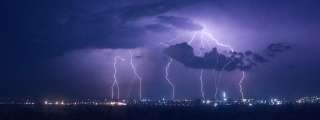The DEHNdetect lightning current measuring system supplies valuable data for research activities on the Gaisberg.
It reliably and comprehensively records all lightning currents – even those with low current impulses, as they occur in ICCOnly events, for example. This is an important consideration, because a large proportion of the lightning events on tall objects – as is the case on the Gaisberg transmitter – are so-called upward flashes. They often have impulses under 1 kA, and conventional lightning detection systems mostly cannot map them.
DEHNdetect in use on the Gaisberg
Team Gaisberg





About the Gaisberg
Lightning research on the Gaisberg
The transmission and radio tower on the Gaisberg is used by ALDIS (Austrian Lightning Detection & Information System) for lightning research. Different lightning current parameters are determined using modern measurement technology as part of the research activities. The following measurements have been performed over the past few years:
- Direct measurement of lightning current amplitude with a shunt from 1998–2018
- Indirect measurement of lightning current amplitude with a Rogowski coil from 2020 to present
- Determining the charge of the individual impulses and the total charge of a lightning strike
- Transient electrical field measurement with plate antennae during a lightning stroke at a distance of 170 m and 130 km
- Measurement of the electrostatic field with a field mill
- Measurement of meteorological data (temperature, air pressure, wind speed)
- Rain measurement with micro rain radar and disdrometer
The transmission mast and the data collected here also provide the perfect opportunity to check the quality of the ALDIS lightning detection system: time, location and lightning amplitude are precisely noted through the measurements. These details can then be compared with the available ALDIS data and potential discrepancies can be identified.






